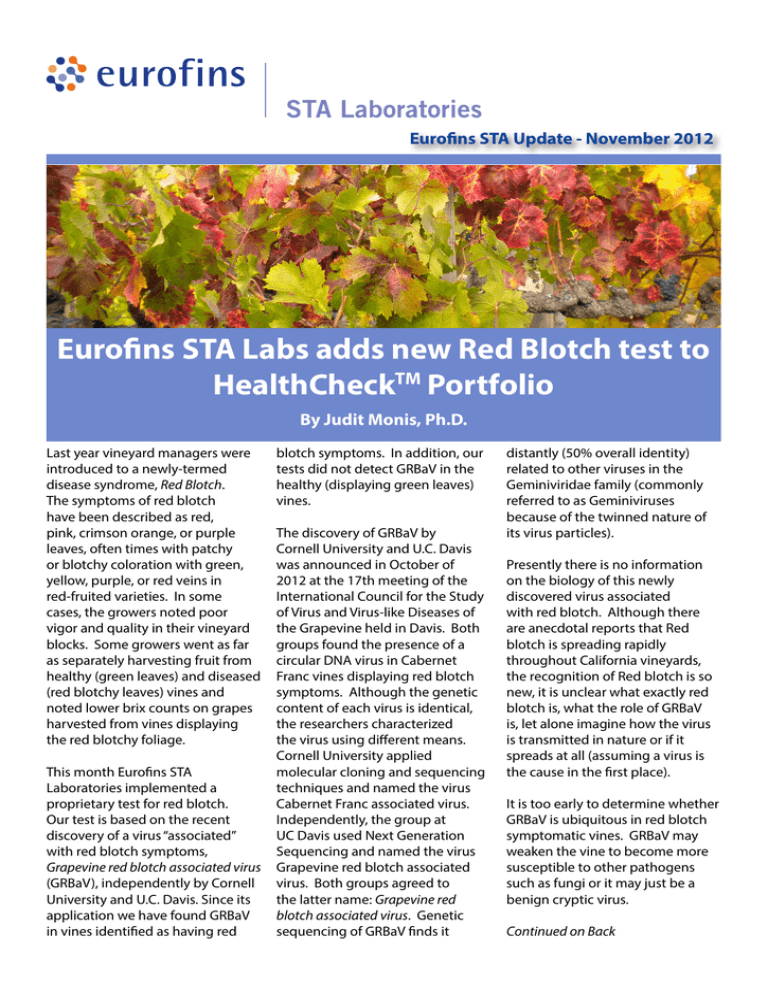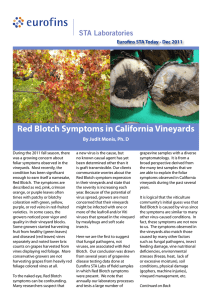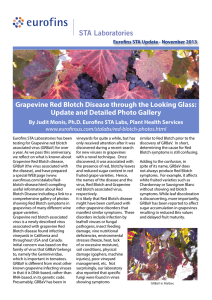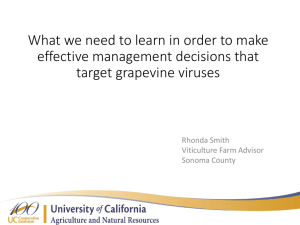Eurofins STA Labs adds new Red Blotch test to HealthCheck Portfolio TM
advertisement

Eurofins STA Update - November 2012 Eurofins STA Labs adds new Red Blotch test to HealthCheckTM Portfolio By Judit Monis, Ph.D. Last year vineyard managers were introduced to a newly-termed disease syndrome, Red Blotch. The symptoms of red blotch have been described as red, pink, crimson orange, or purple leaves, often times with patchy or blotchy coloration with green, yellow, purple, or red veins in red-fruited varieties. In some cases, the growers noted poor vigor and quality in their vineyard blocks. Some growers went as far as separately harvesting fruit from healthy (green leaves) and diseased (red blotchy leaves) vines and noted lower brix counts on grapes harvested from vines displaying the red blotchy foliage. This month Eurofins STA Laboratories implemented a proprietary test for red blotch. Our test is based on the recent discovery of a virus “associated” with red blotch symptoms, Grapevine red blotch associated virus (GRBaV), independently by Cornell University and U.C. Davis. Since its application we have found GRBaV in vines identified as having red blotch symptoms. In addition, our tests did not detect GRBaV in the healthy (displaying green leaves) vines. The discovery of GRBaV by Cornell University and U.C. Davis was announced in October of 2012 at the 17th meeting of the International Council for the Study of Virus and Virus-like Diseases of the Grapevine held in Davis. Both groups found the presence of a circular DNA virus in Cabernet Franc vines displaying red blotch symptoms. Although the genetic content of each virus is identical, the researchers characterized the virus using different means. Cornell University applied molecular cloning and sequencing techniques and named the virus Cabernet Franc associated virus. Independently, the group at UC Davis used Next Generation Sequencing and named the virus Grapevine red blotch associated virus. Both groups agreed to the latter name: Grapevine red blotch associated virus. Genetic sequencing of GRBaV finds it distantly (50% overall identity) related to other viruses in the Geminiviridae family (commonly referred to as Geminiviruses because of the twinned nature of its virus particles). Presently there is no information on the biology of this newly discovered virus associated with red blotch. Although there are anecdotal reports that Red blotch is spreading rapidly throughout California vineyards, the recognition of Red blotch is so new, it is unclear what exactly red blotch is, what the role of GRBaV is, let alone imagine how the virus is transmitted in nature or if it spreads at all (assuming a virus is the cause in the first place). It is too early to determine whether GRBaV is ubiquitous in red blotch symptomatic vines. GRBaV may weaken the vine to become more susceptible to other pathogens such as fungi or it may just be a benign cryptic virus. Continued on Back New Red Blotch Continued The availability of our new test will allow the viticulture industry to learn more about its biology and how widespread this virus is in California vineyards. Ultimately, the association of the virus with typical symptoms will be better understood. In light of the grape grower community’s rapidly increasing concern of red blotch and the newly announced discovery of GRBaV, it is important to understand what “associated virus” means. “Associated virus” means just that. The virus is associated with the disease and not necessarily the cause of it. To prove a pathogen such as a virus, fungus, etc. causes a specific disease, there is a series of experiments that are needed to be completed to demonstrate it is the cause. The process is referred to as Koch’s postulates. In short, the suspect pathogen must first be isolated, introduced into a healthy vine, and later the vine must develop disease symptoms. Red blotch has yet to be proven to be an actual disease. Regardless, red blotch is now part our vocabulary and is being addressed in vineyard health management. Its symptoms are so varied that it could be a redefinition of already known diseases. To the naked eye, red blotch symptoms can be confounding. They resemble many symptoms found in a variety of grapevine disorders (biotic or abiotic) such as fungal pathogens, insect feeding damage, vine nutritional deficiencies, environmental stresses (freeze, heat, lack of or excessive moisture), soil conditions, physical damage (gophers, machine injuries), vineyard management, etc., resulting in still more confusion. Interestingly, our laboratory reported recently that specific fungi were found in all our tested vines showing symptoms similar to red blotch. Because of the similarity between red blotch symptom expression and other diseases, it is even more important to test the vineyards for the presence of fungi, leafroll, and/or Viti viruses in addition to the newly discovered virus. Eurofins STA Laboratories offers a complete set of test panels for all known pathogens including bacteria, fungi, and viruses affecting grapevines. We recommend seasonal virus test panels (HealthCheckTM Panels A and B) for general virus testing and refer to more exhaustive testing such as our new GRBaV panel if needed. We have strong contacts and collaborations related to grapevines with university research groups and testing laboratories within the United States and worldwide that keeps us at the forefront of grapevine disease diagnostics. You can always trust Eurofins STA Laboratories to have the most complete and reliable grapevine testing program anywhere. Feel free to call our lab with questions about red blotch symptoms or any other general vineyard health issue. Our website is always a resource on articles and information on grapevine diseasesplease click on the link: http:// www.eurofinsus.com/stalabs/ products-services-grapevinetesting.html or call us at (408) 8469964 or toll free at (888) 782-5220. STA Laboratories Colorado Laboratory 1821 Vista View Drive Longmont, Colorado 80504 (303) 651-6417 Gilroy Laboratory 7240 Holsclaw Rd. Gilroy, CA 95020 (408) 846-9964 www.eurofinsus.com/stalabs stalabsca@eurofinsus.com






